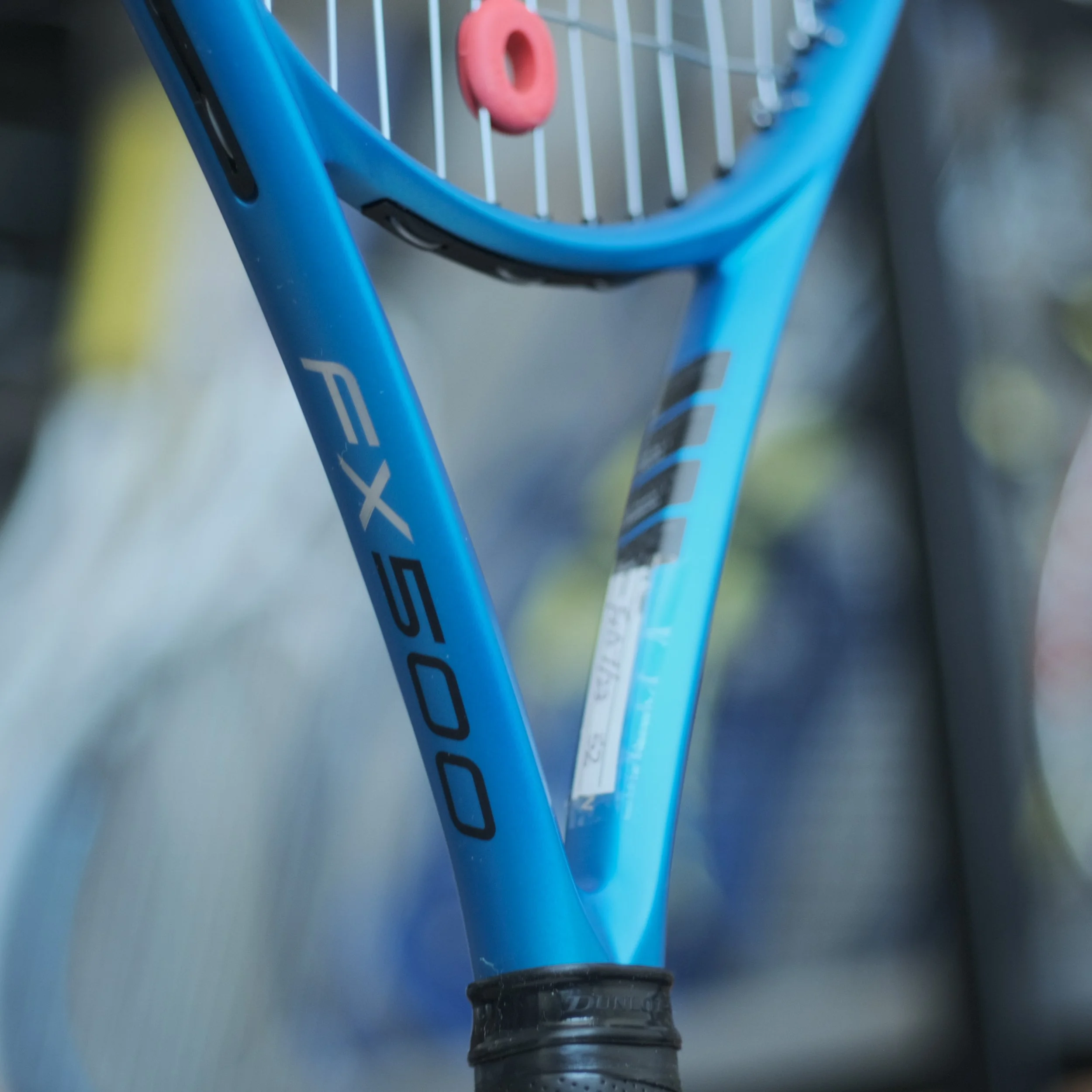The Dunlop FX500 Might Be the BEST Power Racquet on the Market
I’ve found it challenging to care about Dunlop in the past. The FX 500 never really inspired me the way the Pure Aero or EZONE’s have. However, I have been wondering, how is this racquet finding so much success in the hands of Britain's newest hope, Jack Draper, and will his racquet’s retail counterpart help us all unleash massive forehands?
In reality, it looks like Jack is still using his old Dunlop Srixion Revo CV 3.0 F under an FX500 paint job. You can see the mold of the throat is quite different on Jack’s racquet when compared to the new FX500. Other than that, the overall specs between his CV 3.0 F and the new FX 500 are quite similar. Both are 100’s with very thick beams at 23-26-23mm and high stiffnesses around 70RA. The stock swingweights are in the same range, at 317 for the old model and 321 for the FX 500. The stock average twistweight on both models are also quite high, with the Revo coming in at 14.8 and the FX 500 coming at a segment leading 16.2, which is absolutely insane.
Jack’s Game
As a junior, Draper had a very different game than he does now. At 16, he was only 5 foot 7, relying on speed and counter punching to win matches. Today, you can still see the remanence of a scrappy, baselining junior in his game. The way he seems happy to grind out long points, capable of finding the winning pass off either his backhand, or his forehand.
Most tall players tend to hit flatter strokes. The natural height of players like Sinner or Cilic allow them to contact the ball at a higher point, making flat shots the natural choice. Growing up, Jack Draper was always smaller and skinnier than his opponents, so he developed a spin heavy game, regularly averaging over 3000 RPMs on his forehand side in a match. In this hitting footage, you can see Jack really brushing up the back of the ball, laying on a huge amount of topspin. This is something that I personally really struggle with when using high-twistweight racquets like the Pure Aero VS, the EZONE 100 and the 2023 Pure Aero.
And yet, somehow, I found very easy access to the spin from all areas of the court with the Dunlop FX 500.
Spin
The FX500 has a surprisingly quick feel through the air. It’s very easy to accelerate the racquet head, and, as we know, high racquet head speeds are among the most critical factors when it comes to hitting spin. However, there’s something extra that the Dunlop offers beyond simple maneuverability.
There’s so much dwell-time on the stringbed so it really feels like the racquet grips and rips the ball. I did some research, and it seems like this comes from what Dunlop calls the “Power Boost Groove.” Actually, for 2023 it’s called the Power Boost+ Groove, but whatever, it’s just a small channel running under the grommet.
This allows the grommet to flex during ball impact, effectively acting as a sort of suspension system, enhancing the trampoline effect. It really feels like your strings are gripping the ball and slingshotting it out, making the energy transfer feel very efficient. It actually really reminded me of the Bolt series of racquets that we tried recently.
The FX 500 has the same exaggerated trampoline effect where the ball sinks in the stringbed and shoots out with a lot of energy. Dunlop’s Power Groove acts very similarly to Bolt’s zipstrips, but the effect is significantly more mild. Instead of separate flexing pieces, like the Zipstrips, the grommet itself is the foundation of the suspension, flexing downward into the power groove at contact. This tech was available on the last FX500, which I never tried, however, for this year, the groove is 0.5mm deeper and wider than before.
Dunlop says that this equates to about a 5% more efficient rebound, suggesting that it should lead to increased ball speeds. Speaking of increased ball speeds, that’s really what the FX 500 is all about.
Power Level Over 9000
The power on the FX500 feels elastic. For most of us, power can be defined as the combination of ball speed and depth. The FX500 makes it very easy to hit big, deep balls with what feels like a fairly high velocity. The ball shoots off the stringbed with this, sort of, elasticity. If you’ve ever tried natural gut, it has the same kind of elastic power. It feels like the string is really slingshotting the ball off the stringbed. The FX500 has a similar feel, even when strung with a full bed of poly. For this review, I strung this FX 500 with my usual Grapplesnake Tour Sniper 1.25 at 52lbs.
Stability
The stability of the FX 500 is also, really damn good. Which is precisely what you should expect with a 16 twistweight. Just so you know, a 16 twistweight is nuts.
Most mainstream racquets range from 14 to 15. Other manufacturers really haven’t bothered to increase twistweight beyond 15 in 100 square inch racquet. As I’m learning, Dunlop is really pushing the envelope when it comes to innovation.
The combination of the Power Groove suspension system, the super high twistweight, the 69RA and very thick 26mm beam make this easily the most torsionally stable tennis racquet I’ve used. There is almost zero fluttering on off centre shots, with plenty of power, spin and ball pocketing available throughout the stringbed. Even service returns comes quite easily for such a light racquet.
Feel
As mentioned, there’s an elastic feel to the FX 500. The dwell-time feels extremely long when compared to the Pure Drive or the EZONE 100. I really think that this must be due to the Power Groove thing, because I just haven’t tried other racquets with this high of an RA that can hold the ball on the strings for as long as the FX 500 can. Even though the ball-pocketing is top-notch, the racquet’s feel is not too muted.
The overly muted racquets that currently dominate the 100 square inch racquet segment have been one the primary reasons that I’m struggling to find a replacement for my Extreme Tour. The majority of the racquet industry is trying to dampen stiff racquets to retain power and stability without sacrificing comfort. The leading examples are Yonex’s Vibration Dampening Mesh and Babolat’s Cortex C2 Pure Feel. I don’t think that this is the right move because the dampening kills the feel in all these racquets.
I much prefer Dunlop’s application of suspension to add comfort. It reduces the amount of shock that’s transferred from the stringbed to the frame without sapping every drop of feel. This results in a stellar combination of feel, comfort and ball-pocketing. Dunlop’s Power+ Groove is also a lot more predictable and controllable than the suspension found in the Bolt racquets.
Control
This is always one of my biggest concerns with these power racquets. The muted feel and open stringbed of the Pure Drive make it hard to locate your contact point on the stringbed, making control relatively unpredictable. The EZONE 100 is better, with a denser stringbed and a more connected feel, but I struggled to generate spin to control the ball due to below average maneuverability.
I’m really looking to find a more powerful racquet for my own game, but haven’t quite found a 100 square inch racquet that offers enough control to tame their massive power. While control and precision isn’t a pure strength of the FX500, it is something that really impressed me relative to other racquets in this segment.
The feel is much more connected than the Pure Drive, so you can easily locate the ball on the stringbed. The amount of spin that you can generate with the FX 500 makes it a lot easier to control the ball than the EZONE 100.
Final Thoughts
The combination of the great feel, incredible stability and surprisingly good spin make the Dunlop FX500 one of the most appealing 100 square inch racquets on the market. It’s a racquet that allowed me to channel the big, heavy hitting of Jack Draper.
Taking massive, loopy cuts at the ball is incredibly rewarding with the Dunlop FX 500.
If you are looking for a Pure Drive with better feel, this is your racquet.
If you are looking for an EZONE 100 that’s a little faster through the air, this is your racquet.
If you want easy access to depth, power, spin and stability, there is simply no better choice than the Dunlop FX 500.





